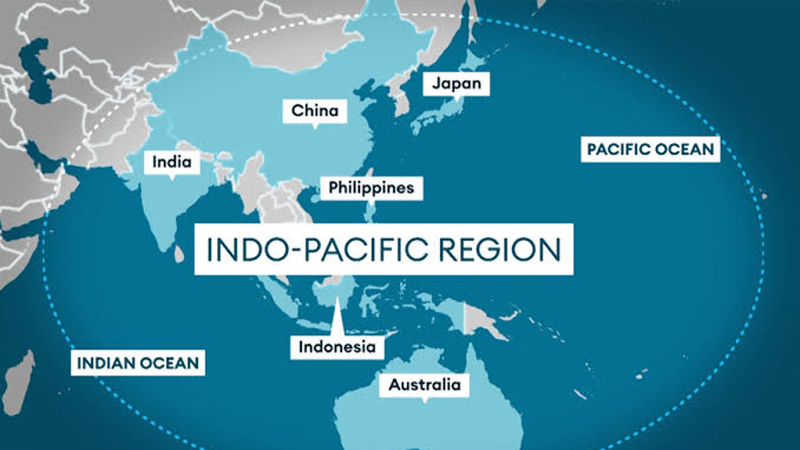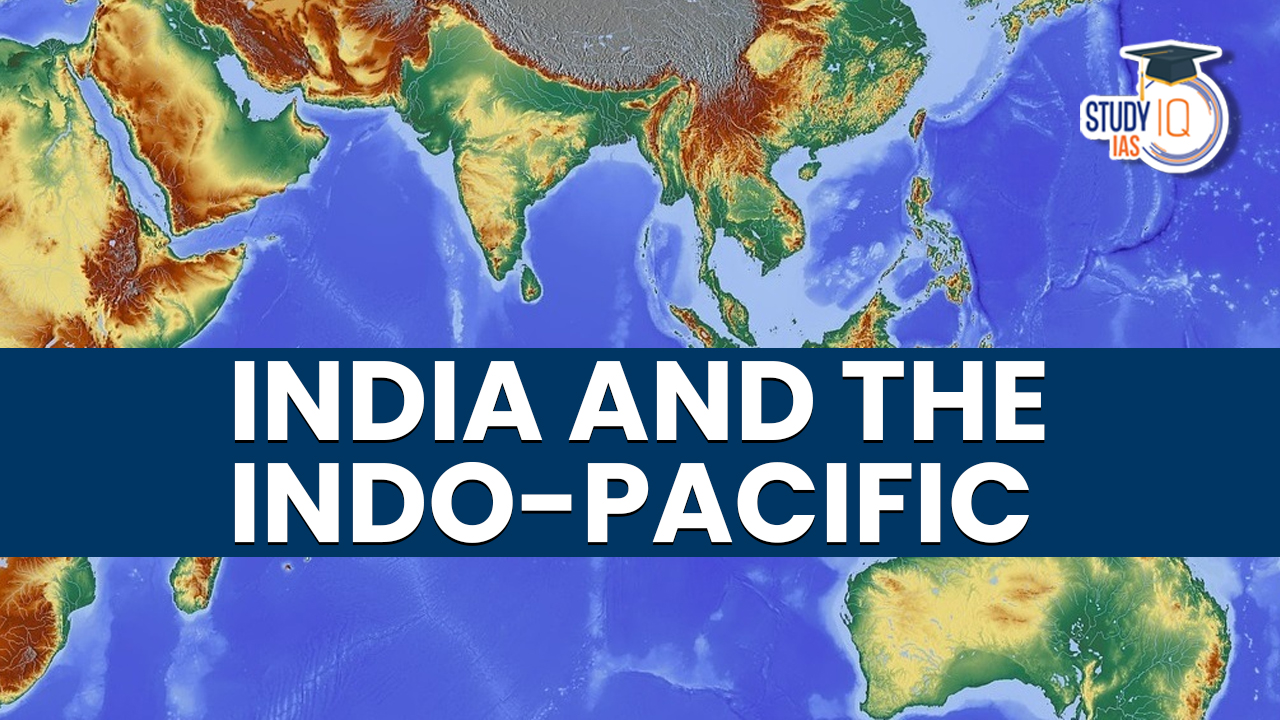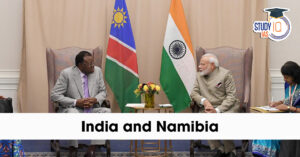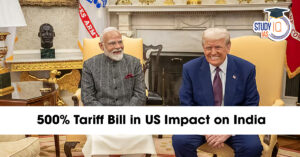Table of Contents
Context: The inauguration of Donald Trump as the 47th President of the United States signals a vital moment in global geopolitics, particularly for the Indo-Pacific region. The presence of the foreign ministers from India, Japan, and Australia — America’s key Quad partners — at the inauguration underscores the strategic importance of this grouping in Mr. Trump’s foreign policy vision.
First Term: Trump’s Stance on the Indo-Pacific Region
Adoption of the Term ‘Indo-Pacific’
- Shift in Terminology: Trump’s administration replaced ‘Asia-Pacific’ with ‘Indo-Pacific,’ expanding the strategic focus to include the Indian Ocean.
- Geopolitical Recalibration: This reflected a wider lens critical to global trade, security, and stability, with an intent to counter China’s influence.
- Focus Areas: Emphasised securing sea lines of communication, addressing maritime challenges, and integrating defence, security, and political considerations alongside economic cooperation.

Structural Changes in U.S. Defence Strategy
- Rebranding of Command: Renamed the S. Pacific Command as the U.S. Indo-Pacific Command in 2018, highlighting the region’s operational importance.
- Specialised Units: Established units within the Office of the Secretary of Defence to focus on partnerships with Indo-Pacific allies.
Revival of the Quad Alliance
- Recognition of the Quad: Trump identified the Indo-Pacific as the fulcrum of 21st-century geopolitics, strengthening the Quad partnership with India, Japan, and Australia.
- Institutionalisation: Elevated the Quad dialogue to the ministerial level, focusing on:
- Maritime security
- Supply chain resilience
- Technological standards
Legacy and Continuity Under Joe Biden
Biden’s Approach: The Indo-Pacific framework developed under Trump was inherited and expanded by the Biden administration.
- First Quad Leaders’ Summit (2021): Convened to deepen collaboration.
- Indo-Pacific Economic Framework (2022): Complemented the strategic focus with economic engagement.
- Broad Agenda: Included vaccines, climate change, critical technologies, and infrastructure development.
- Emphasis: Multilateralism and rules-based order aligned the Quad’s mission with global governance goals.
Hopes for Trump’s Second Term: Key Prospects in the Indo-Pacific Region
Assertive Stance on China
Likely to adopt a stronger hard-power approach to counter China’s rising influence in the Indo-Pacific. At his confirmation hearing, S. Secretary of State Marco Rubio described China as the U.S.’s “most formidable adversary.”
Strengthened Quad Cooperation
- Inaugural Quad Meeting: Foreign ministers of India, Japan, and Australia attended Trump’s inauguration, reflecting the importance of the Quad in his foreign policy vision.
- First Major Initiative: A meeting of Quad foreign ministers on January 21, 2025, reaffirmed the U.S.’s commitment to the Indo-Pacific.
- Key Outcomes:
- Commitment to international law, peace, stability, and maritime security.
- Opposition to unilateral actions that alter the status quo through coercion.
- Emphasis on resilient supply chains and technological security.
- Agreement on regular ministerial meetings and preparation for a Quad leaders’ summit hosted by India.
Focus on Defence and Hard Power Dynamics
Expected to boost security frameworks to ensure regional stability. Likely to prioritise maritime and technological security while addressing emerging threats.
Shared Responsibility Among Allies
Reliance on India, Japan, and Australia to share the burden of regional security. Bilateral meetings, with India being the first partner to engage with the new administration.
Preservation of Rules-Based Order
Trump’s administration is expected to balance hard power strategies with broader mechanisms to uphold the rules-based order and regional prosperity.
Understanding the Indo-Pacific Region
- The Indo-Pacific is a geopolitical construct that substituted the term “Asia-Pacific”. It covers the area from Africa’s east coast to America’s west coast. It encompasses the Indian Ocean and the Pacific Ocean.
- Major stakeholders in the Indo-Pacific: QUAD (India, U.S.A., Australia, Japan), Association of Southeast Asian Nations (ASEAN) members, China, and other maritime nations occupy the strategic positions in the Indian and the Pacific Ocean.
Significance of Indo-Pacific for India
| Aspect | Details |
| Economic Significance |
|
| Strategic significance |
|
Challenges for India in Indo-Pacific
- Security of Sea Lanes of Communication is an essential challenge as the region is prone to maritime piracy in areas like piracy in the waters of the Indian Ocean, Sulu Sea, and South China Sea (SCS).
- Freedom of navigation as China’s claims of sovereignty in the waters of SCS and increased presence in the Indo-Pacific is hampering the free movement of vessels.
- China’s BRI and the so-called String of Pearls aim to encircle India from all borders.
- The ‘Air Silk Route,’ a newer Chinese initiative, is a new chapter in the Indo-Pacific region.
- India’s capability as a net security provider is being tested as ASEAN members perceive India as a counterweight against Chinese aggression. But India’s Naval and military capability, although rising, are yet to match the levels of China.
- Differences in groupings: E.g., India opted out of RCEP, which did not receive a good response from other members like ASEAN and Australia.
- Quad’s Limitations: The Quad has a fundamental structural flaw because its goal revolves around the United States. And the group lacks a strategic vision.
- Natural Disasters and Climate: Coping with natural disasters like cyclones and tsunamis, combined with high population density and the growing threat of climate change, presents additional challenges in the region.
- Security Threats: Tackling terrorism, radicalization, resource scarcity, and environmental issues contributing to regional volatility.
Steps taken by India to realize the potential of the Indo-Pacific Region
- The Ministry of External Affairs established a new Division for the Indo-Pacific in April 2019.
- Indo-Pacific Oceans Initiative (IPOI): It is an open, non-treaty-based initiative launched by India in 2019, to promote maritime cooperation in the Indo-Pacific region.
- IPOI envisages cooperation under seven pillars namely, Maritime Security, Maritime Ecology, Maritime Resources, Capacity Building and Resource Sharing, Disaster Risk Reduction and Management, Science, Technology and Academic Cooperation and Trade, Connectivity and Maritime Transport.
- ASEAN Centrality: India’s association with ASEAN has been on the rise. This development is in line with India’s policy of the ASEAN to be at the centre of the Indo-Pacific.
- The IPOI is an appropriate fit for the ASEAN Outlook on Indo-Pacific (AOIP).
- Regional and Bilateral Groupings: The QUAD mechanism at a regional and plurilateral level, and our bilateral engagement with individual countries of the Indo-Pacific have intensified.
- IPEF: On the economic side, India has decided to join the Indo-Pacific Economic Framework (IPEF).
- IPEF is a US-led trade initiative meant to counter China’s aggressive expansion in the region.
- It includes seven out of 10 members of the Association of South East Asian Nations (ASEAN), all four Quad countries, and New Zealand, representing about 40% of global GDP.
- Indo-Pacific Maritime Domain Awareness Initiative: concentrates on maritime safety, illegal, unreported, and unregulated (IUU) fishing and consequences of natural disasters. This initiative can help fill many gaps in the region.
- Security and Defence: E.g., Indian Navy’s Information Fusion Centre for the Indian Ocean region, Indian Ocean Naval Symposium and Exercises like Malabar.
- Humanitarian assistance and disaster relief: India has established itself as an early responder through initiatives like Operation Vanilla and Coalition for Disaster Resilient Infrastructure etc.


 India-Namibia Relations, Key Areas and S...
India-Namibia Relations, Key Areas and S...
 500% Tariff Bill in US: Concerns and Imp...
500% Tariff Bill in US: Concerns and Imp...
 India and Trinidad and Tobago: Strengthe...
India and Trinidad and Tobago: Strengthe...





















